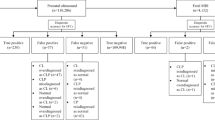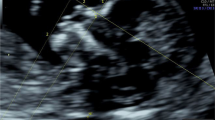Abstract
Purpose
The aim of our study was to investigate the role of fetal magnetic resonance imaging (MRI) as a complement to ultrasound (US) in the evaluation of cleft lip and palate (CLP), whether isolated or in association with syndromic conditions.
Materials and methods
We enrolled 24 pregnant women (27 fetuses) (mean gestational age 23.7 weeks) with a level-two US diagnosis of cleft lip (CL) or CLP with or without associated central nervous system (CNS) or facial-bone anomalies. All individuals underwent a fetal MRI examination to study the facial skeleton, CNS and fetal body. For each fetus, the main anatomical facial landmarks and biometric parameters [anteroposterior diameter (APD), biparietal diameter (BPD), inferior facial angle (IFA), frontomaxillary angle (FMA), bi-orbital diameter (BOD), intraorbital diameter (IOD)] were measured.
Results
Twenty-five of 27 fetuses had a US diagnosis of CL or CLP. MRI confirmed the diagnosis in 16/25 fetuses and added information about the extent of the cleft and the degree of involvement of the anterior and posterior palate in 8/25 fetuses. MRI ruled out the diagnosis in 1/25 fetuses and identified an alteration of the parameters IFA, FMA and IOD in 6/24 fetuses.
Conclusions
In the study of CLP fetal, MRI is able to define the degree of involvement of the posterior palate and the lateral extent of the cleft with higher diagnostic accuracy than US. Furthermore, MRI provides a complete study of the fetal head and biometric development of the facial bones, thus enabling early detection of potential syndromic conditions.
Riassunto
Obiettivo
Lo scopo del nostro studio è valutare il ruolo complementare, rispetto all’esame ecografico, della risonanza magnetica (RM) fetale nell’inquadramento delle labioschisi (LBS) o labio-palatoschisi (LPS) isolate e associate a quadri sindromici.
Materiali e metodi
Abbiamo prospettivamente arruolato 24 donne in gravidanza (27 feti; età gestazionale media 23,7 settimane) con diagnosi ecografica di II livello di LBS o LPS, associata o meno ad anomalie cranio-encefaliche o del massiccio facciale; le pazienti sono state sottoposte a RM fetale per lo studio del massiccio facciale, oltre che del sistema nervoso centrale (SNC) e del body fetale. Per ogni feto abbiamo valutato i principali reperi anatomici del massiccio facciale e calcolato i seguenti parametri riguardanti il suo normale sviluppo: diametro anteroposteriore della mandibola (DAPM), diametro biparietale della mandibola (DBPM), angolo facciale inferiore (IFA), angolo fronto-mascellare (FMA), diametro bisorbitario (DBO), diametro interorbitario (DIO).
Risultati
Venticinque/27 feti avevano diagnosi ecografica di LBS-LPS. La RM ha confermato la diagnosi ecografica in 16/25 feti ed ha aggiunto informazioni riguardo l’estensione della schisi ed il coinvolgimento del palato in 8/25 feti; ha smentito la diagnosi in 1/25 feti. Inoltre abbiamo evidenziato in 6/24 feti un’alterazione dei parametri IFA, FMA, DIO.
Conclusioni
Lo studio RM fetale del massiccio facciale nelle LBS-LPS definisce con maggiore accuratezza il grado di coinvolgimento del palato posteriore e la lateralità; consente, inoltre, una valutazione del distretto cranioencefalico e dello sviluppo biometrico del massiccio facciale al fine di identificare precocemente eventuali condizioni sindromiche.
Similar content being viewed by others
References/Bibliografia
Stroustrup Smith A, Estroff JA, Barnewolt CE et al (2004) Prenatal diagnosis of cleft lip and cleft palate using MRI. AJR Am J Roentgenol 183:229–235
Sonek J, Borenstein M, Downing C et al (2007) Frontomaxillary facial angles in screening for trisomy 21 at 14–23 weeks’ gestation. Am J Obstet Gynecol 197:160–165
Borenstein M, Persico N, Dagklis T et al (2007) Frontomaxillary facial angle in fetuses with trisomy 13 at 11 + 0 to 13 + 6 weeks. Ultrasound Obstet Gynecol 30:819–823
Borenstein M, Persico N, Strobl I et al (2007) Frontomaxillary and mandibulomaxillary facial angles at 11 + 0 to 13 + 6 weeks in fetuses with trisomy 18. Ultrasound Obstet Gynecol 30:928–933
Rajeswaran R, Chandrasekharan A, Joseph S et al (2008) Ultrasound versus MRI in the diagnosis of fetal head and trunk anomalies. J Matern Fetal Neonatal Med 13:1–9
Pilu G, Segata M (2007) A novel technique for visualization of the normal and cleft fetal secondary palate: angled insonation and threedimensional ultrasound. Ultrasound Obstet Gynecol 29:166–169
Goldstein I, Jakobi P, Tamir A, Goldstick O (1999) Nomogram of the fetal alveolar ridge: a possible screening tool for the detection of primary cleft palate. Ultrasound Obstet Gynecol 14:333–337
Tamsel S, Ozbeka SS, Senera RN et al (2004) MR imaging of fetal abnormalities. Comput Med Imaging Graph 28:141–149
Ramos GA, Ylagan MV, Romine LE et al (2008) Diagnostic evaluation of the fetal face using 3-dimensional ultrasound. Ultrasound Q 24:215–223
Ghi T, Tani G, Savelli L et al (2003) Prenatal imaging of facial clefts by magnetic resonance imaging with emphasis on the posterior palate. Prenat Diagn 23:970–975
Rotten D, Levaillant JM (2004) Two- and three-dimensional sonographic assessment of the fetal face. 1. A systematic analysis of the normal face. Ultrasound Obstet Gynecol 23:224–231
Borenstein M, Persico N, Kaihura C (2007) Frontomaxillary facial angle in chromosomally normal fetuses at 11 + 0 to 13 + 6 weeks. Ultrasound Obstet Gynecol 30:737–741
Ulm MR, Kratochwil A, Ulm B et al (1998) Three-dimensional ultrasound evaluation of fetal tooth germs. Ultrasound Obstet Gynecol 12:240–243
Njio B, Kjær I (1993) The development and morphology of the incisive fissure and the transverse palatine suture in the human fetal palate. J Craniofac Genet Dev Biol 13:24–34
Mueller DT, Callanan VP (2007) Congenital malformations of the oral cavity. Otolaryngol Clin North Am 40:141–160
Dane B, Dane C, Aksoy F, Yayla M (2009) Semilobar holoprosencephaly with associated cyclopia and radial aplasia: first trimester diagnosis by means of integrating 2D-3D ultrasound. Arch Gynecol Obstet 280:647–651
Kjaer I, Keeling JW, Fischer Hansen B, Becktor KB (2002) Midline skeletodental morphology in holoprosencephaly. Cleft Palate Craniofac J 39:357–363
Manganaro L, Savelli S, Francioso A et al (2009) Role of fetal MRI in the diagnosis of cerebral ventriculomegaly assessed by ultrasonography. Radiol Med 114:1013–1023
Roelfsema NM, Hop WC, Wladimiroff JW (2006) Three-dimensional sonographic determination of normal fetal mandibular and maxillary size during the second half of pregnancy. Ultrasound Obstet Gynecol 28:950–957
Rotten D, Levaillant JM, Martinez H et al (2002) The fetal mandible: a 2D and 3D sonographic approach to the diagnosis of retrognathia and micrognathia. Ultrasound Obstet Gynecol 19:122–130
Wang G, Shan R, Zhao L et al (2010) Fetal cleft lip with and without cleft palate: Comparison between MR imaging and US for prenatal diagnosis. Eur J Radiol DOI:10.1016/j.ejrad.2010.03.026
Perrone A, Savelli S, Maggi C et al (2008) Magnetic resonance imaging versus ultrasonography in fetal pathology. Radiol Med 113:225–241
Prayer D, Brugger PC, Prayer L (2004) Fetal MRI: techniques and protocols. Pediatr Radiol 34:685–693
Costello BJ, Edwards SP, Clemens M (2008) Fetal diagnosis and treatment of craniomaxillofacial anomalies. J Oral Maxillofac Surg 66:1985–1995
Kazan-Tannus JF, Levine D, McKenzie C et al (2005) Real-time magnetic resonance imaging aids prenatal diagnosis of isolated cleft palate. J Ultrasound Med 24:1533–1540
Levine D, Cavazos C, Kazan-Tannus JF et al (2006) Evaluation of real-time single-shot fast spin-echo MRI for visualization of the fetal midline corpus callosum and secondary palate. AJR Am J Roentegenol 187:1505–1511
Mailáth-Pokorny M, Worda C, Krampl-Bettelheim E et al (2010) What does magnetic resonance imaging add to the prenatal ultrasound diagnosis of facial clefts? Ultrasound Obstet Gynecol 36:445–451
De Ponte FS, Bottini DJ, Maggi E et al (1998) Prenatal diagnosis: evolution in craniofacial surgery. J Craniofac Surg 9:190–195
Johnson N, Sandy JR (2003) Prenatal diagnosis of cleft lip and palate. Cleft Palate Craniofac J 40:186–189
Descamps M, Golding S, Sibley J et al (2010) MRI for definitive in utero diagnosis of cleft palate: a useful adjunct to antenatal care? Cleft Palate Craniofac J 47:578–585
Author information
Authors and Affiliations
Corresponding author
Rights and permissions
About this article
Cite this article
Manganaro, L., Tomei, A., Fierro, F. et al. Fetal MRI as a complement to US in the evaluation of cleft lip and palate. Radiol med 116, 1134–1148 (2011). https://doi.org/10.1007/s11547-011-0683-8
Received:
Accepted:
Published:
Issue Date:
DOI: https://doi.org/10.1007/s11547-011-0683-8




